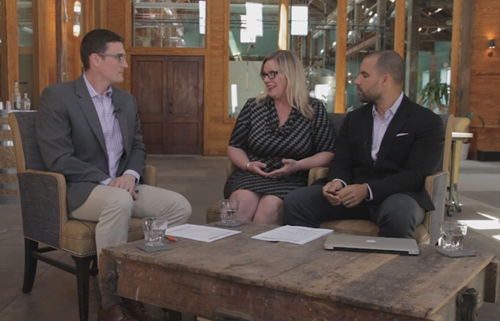Show Recap - Digital Transformation in Marketing
Hot on the heels of Harvard Business Review trying to answer the question as to why B2B marketers say they’re even less effective at content marketing than they were in 2014, Industry Analyst and Founder of Digital Clarity Scott Liewehr and Marketing Director Tyler Pyburn sat down with me to share ideas about the current state of digital transformation, specifically marketing’s role in the 50th episode of the CMS-Connected Show. Here are some highlights from that captivating conversation:

Q: Why should an organization be concerned about digital transformation?
Daniel Newman wrote for Forbes late last year: “Your business may hang on to a core group of customers for a while, but without undergoing a digital transformation, you simply won’t make it.”
My take is that companies need to transform two major ways; looking outward in how they seek out technologies to utilize to be more productive and inward – how they adapt to the usage of technology – whether it’s their employees or their customers using that technology. Suddenly, we have these amazing technologies that can save millions of dollars for large companies. I'll give the example of say, a construction worker. Labor is 40% of construction costs and 29% of a worker's day is spent idle waiting for permits. You get a mobile app you save the costs of about one day a week for every employee. It's amazing people are still using paper.
In the case of say marketing, it’s looking inward. Our customers are using technology in new ways all the time, and many of us are still marketing like it’s 2005. So we’re losing opportunities and our customers.
Q: What exactly is a digital transformation?
Some say what’s going on right now it actually a third stage of embracing digital technologies. The first two were: digital competence and digital literacy. Digital is not new, we’ve been using email and websites since the 1990s and 2000s. However, the key here is that now digital is a two-way conversation. With social media the consumer now demands to be part of the conversation. Most of us are still using “old school” marketing methods. Being digital means sending emails and Tweets out, showing consumers ads. Just like we used to send brochures and buy newspaper ads, but digital transformation, this is a whole new ball game. It requires new ways of thinking, rather than simply enhancing and supporting the traditional methods.
Only 1% of millennials trust the products in ads. They see them as not authentic. That’s why everywhere you go you hear about content marketing. You have content, and you have marketing. But when you put those two words together it transforms the meaning of both words. Content actually needs to be relevant to your customers that is where the marketing strategy comes in, and marketing actually becomes less about marketing and more about providing valuable information for your audience so they can do their jobs and make the right purchasing decisions, whether it’s your product, or someone else’s. It’s also about providing places they can get together and learn from their colleagues. We need to curate and nurture conversations now, be where the action is.
Q: What are some of the biggest challenges around digital transformation?
We can tie back into this being the third stage of embracing digital technologies – it makes the whole idea of what “digital transformation” is fairly confusing. I think a lot of CEOs, companies think we have already done the “digital transformation” because we’re using email, blogs and paid digital media. It goes back to that two-way conversation. People overuse the term disruption but this really is disruptive. It’s not as clear as telling your team – ok we need to phase out flyers and mailings or telemarketing to focus on digital. Now we’re telling them – they need to completely rethink HOW they are Tweeting.

The way they Tweeted in 2013, or even 2015 is not going to work. It can be frustrating on both ends, like those who are evangelizing cannot understand those who want to keep things the way they are and the other way around.
There are some positives around these challenges though. In a McKinsey and Company interview last month James Bilefield (pictured left) called digital transformation a Trojan horse for a much broader business transformation, “A time to review many aspects of a business’s operations from top to bottom—the talent, the organizational structure, the operating model, even products and services” and this rings true to my experience. Digital transformation is like the ultimate desiloization process for organizations, it gets everyone talking to each other and sharing ideas and resources and that is invaluable.
Q: How quickly can you see results when you’ve used digital transformation best practices?
It’s actually shocking how quickly you can see results when you apply best practices such as Joe Pulizzi’s (Founder of the Content Marketing Institute) 4-1-1- rule - however the flip side of this is that again we are still trying to figure out how to use technology to measure some of these fairly new practices and prove that they eventually become leads. If you think about it, software that measures marketing KPIs has been completely designed for very traditional “push marketing” such as tracking visits back to product websites. It is not surprising that it is not easy to measure say - the free sharing of third party content or engagement marketing - because those technologies simply weren’t set up to!
Q: What are some key personality traits you need to look for in hiring teams to be successful at digital transformation?
You need have a lot of humility. What you see as best practices can vary – or certainly needs to bend on occasion – and you need to be open to listening to teams. Even as the expert in content marketing, if you don’t listen to the traditional marketing and product teams you will lose out.
You need to constantly be educating yourself about the newest trends and be agile – again there’s the humility – being aware that things are constantly changing and what you thought you knew about your audience, or certain marketing channels, it’s probably changed radically in the past six months!
James Bilefield talks about “putting a designer on your executive team, like we have at Apple now, or even making a designer your CEO, as Burberry has recently done.” We’re going to see more organizations hire journalists as marketers. Nontraditional skill sets – or a mix of disciplines – are becoming more valuable and there’s kind of a multidisciplinary approach that’s becoming compelling to employers.
McKinsey says that building a culture of constant change by getting outside your comfort zone is key to success. An entrepreneurial employee, who has a real desire to make things work and is driven to combat challenges by coming up with original solutions is the type of person you want to think about hiring. Since right now we’re in such early stages with content marketing. You’ve got to be inventive.
Q: How did you end working in digital transformation?
I literally fell into marketing and I have to say at the right place and right time. I have a great deal of intellectual curiosity, but I have to say from what I know the marketing of 1995 might not have interested me like the marketing of 2015 which is so focused on understanding and engaging with your audience. So you’re really learning so much about the topics your customers care about when you’re strategizing content for them. It’s like one day I am reading about biotechnology in India, the next day about futuristic predictions about the youngest American generation called “cybrids”. It doesn’t get much cooler than this. In the mid-2000s, I was exposed to all the thought leaders like Gary Vaynerchuk and Guy Kawasaki at the time, I was excited about what they said. Although I am sure I didn’t 100% understand it or even apply it, slowly it started to sink in. When I don’t have patience for others, I have to remember that it literally took me years to become the type of marketer I am now.
Also, the exposure to the industries I worked in certainly rubbed off. The companies I worked for were all early adopters up against unique challenges - whether it was the beginnings of the online furniture industry, online grocery becoming mainstream, new ways of selling insurance or enterprise mobility software.
A Forrester report last year said that only 5% of organizations feel they have mastered digital to a point of differentiation from their competitors. It’s a whole new language. When we transitioned from ads in the newspaper or mailings to email, we used the same methods in some ways. Now we really are turning everything completely on its head. Suddenly, it’s not about putting yourself in front of the competitor, it’s acknowledging your competitor exists, and even, in some cases, providing information about your competitor to educate your audience. This sort of thinking is really a complete 180, but we don’t really have a choice if we want to compete as organizations.
Here is the entire conversation below:

Leah Kinthaert
Leah is a Demand Generation Expert with 10 years of B2C and B2B marketing experience and is currently a Digital Transformation Lead at Informa. Previously, she was Director of Marketing at Mobilengine where she managed content strategy, curation, and editorial to deliver creative, intelligent, and relevant content for their website and all social channels. Prior to Mobilengine, she was the Acquisition Marketing Manager at InsuraMatch.